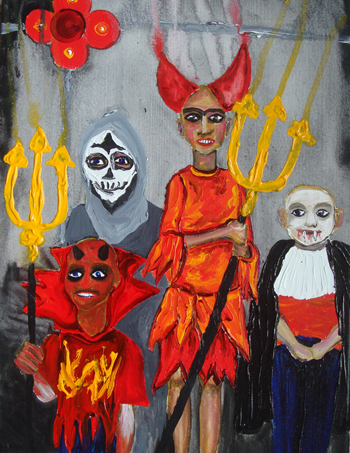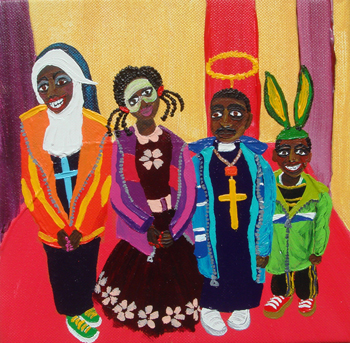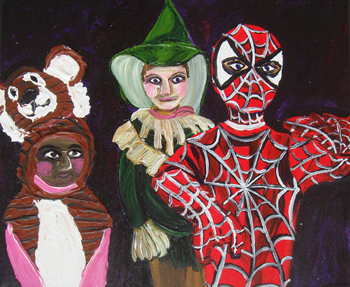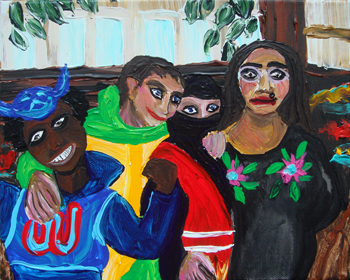




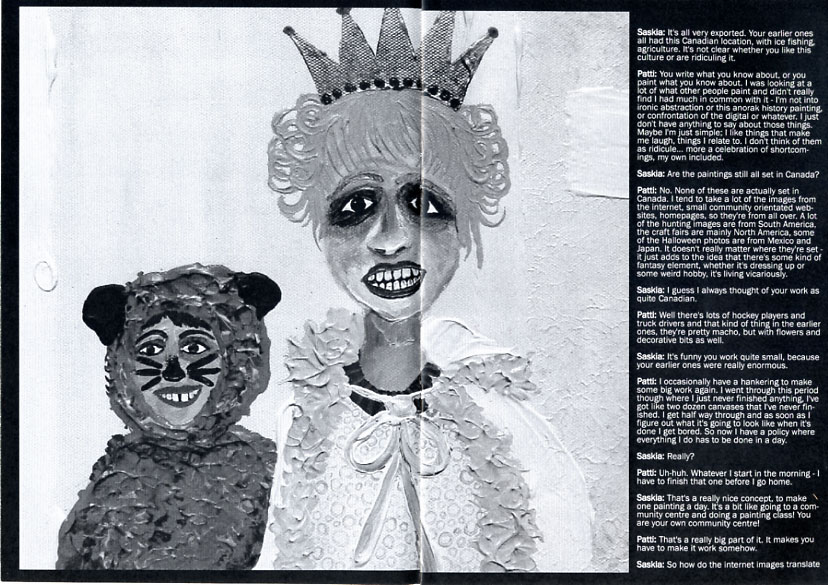
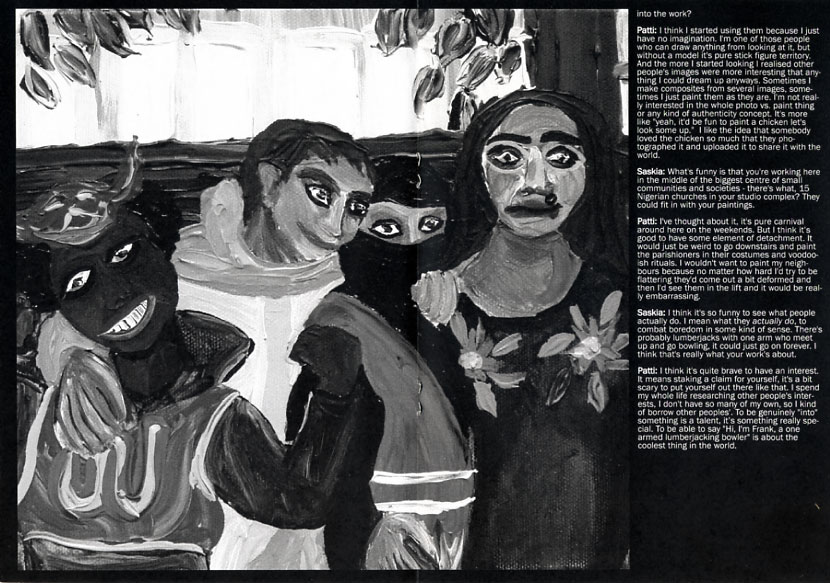




//// //// //// //// ////
//// ///
TALENT SHOW
Patricia Ellis
Saskia Olde Wolbers: Your work has changed a lot since I last saw it. The paintings of hunters have been replaced with fancy dress parties.
Patricia Ellis: I tend to work in groups, so there were the hunters, and then craft fairs, then hockey games, and kids with Halloween costumes, and recently I've started to do hen nights.
Saskia: NO!
Patti: YEAH! I like the idea of these self-made communities, they're really goofy and sympathetic. It's all about imagination, if you're a hunter you can go out and pretend to be Rambo, or a naughty nun or Playboy bunny on hen nights. There's a kind of sentimentality that goes along with that, it's making fantasy an integral part of life's most important moments.
Saskia: What about the ones with no people in it?
Patti: When I started those I was toying with the use of space. Craft fairs usually start off with a makeshift square booth, which is then adorned with all this lovingly made tat. I used that as an approach to formal painting. The one with the barn started off as being a complete abstract and then I just put the kids and banners in.
Saskia: I could have seen that as an abstract. I guess it would have been a more "fashionable" painting.
Patti: At the time I made it there was a lot of abstraction going about - people were doing loads of coloured squares on canvas, wonky hand painted grids. I became interested in dressing up formalism, where the same types of compositions could be used to describe barns or hockey arenas. Half the purpose of painting is actually having an image. I think a lot of people don't talk about image as being a huge part of painting. For me, to make something abstract just seems like a cop out.
Saskia: You seem to have abandoned the mid-life crisis world of the old hunter in the forest on his own, and they've become a bit more party orientated ... also the painting has become much looser.
Patti: I never really learned how to paint, I just paint like I draw, fill in a general shape, add the shading and detail afterwards. Recently I started working with bigger brushes and making things a lot faster.
Saskia: If you were living in a village would you go down to the local craft fair and paint the crafts?
Patti: When you're in it you just take it for granted. When I lived in the sticks I was making work about fame and corporate culture.
Saskia: It's all very exported. Your earlier ones all had this Canadian location, with ice fishing, agriculture. It's not clear whether you like this culture or are ridiculing it.
Patti: You write what you know about, or you paint what you know about. I was looking at a lot of what other people paint and didn't really find I had much in common with it - I'm not into ironic abstraction or this anorak history painting, or confrontation of the digital or whatever. I just don't have anything to say about those things. Maybe I'm just simple; I like things that make me laugh, things I relate to. I don't think of them as ridicule... more a celebration of shortcomings, my own included.
Saskia: Are the paintings still all set in Canada?
Patti: No. None of these are actually set in Canada. I tend to take a lot of the images from the internet, small community orientated websites, homepages, so they're from all over. A lot of the hunting images are from South America, the craft fairs are mainly North America, some of the Halloween photos are from Mexico and Japan. It doesn't really matter where they're set - it just adds to the idea that there's some kind of fantasy element, whether it's dressing up or some weird hobby, it's living vicariously.
Saskia: I guess I always thought of your work as quite Canadian.
Patti: Well there's lots of hockey players and truck drivers and that kind of thing in the earlier ones, they're pretty macho, but with flowers and decorative bits as well.
Saskia: It's funny you work quite small, because your earlier ones were really enormous.
Patti: I occasionally have a hankering to make some big work again. I went through this period though where I just never finished anything, I've got like two dozen canvases that I've never finished. I get half way through and as soon as I figure out what it's going to look like when it's done I get bored. So now I have a policy where everything I do has to be done in a day.
Saskia: Really?
Patti: Uh-huh. Whatever I start in the morning - I have to finish that one before I go home.
Saskia: That's a really nice concept, to make one painting a day. It's a bit like going to a community centre and doing a painting class! You are your own community centre!
Patti: That's a really big part of it. It makes you have to make it work somehow.
Saskia: So how do the internet images translate into the work?
Patti: I think I started using them because I just have no imagination. I'm one of those people who can draw anything from looking at it, but without a model it's pure stick figure territory. And the more I started looking I realised other people's images were more interesting that anything I could dream up anyways. Sometimes I make composites from several images, sometimes I just paint them as they are. I'm not really interested in the whole photo vs. paint thing or any kind of authenticity concept. It's more like "yeah, it'd be fun to paint a chicken let's look some up." I like the idea that somebody loved the chicken so much that they photographed it and uploaded it to share it with the world.
Saskia: What's funny is that you're working here in the middle of the biggest centre of small communities and societies - there's what, 15 Nigerian churches in your studio complex? They could fit in with your paintings.
Patti: I've thought about it, it's pure carnival around here on the weekends. But I think it's good to have some element of detachment. It would just be weird to go downstairs and paint the parishioners in their costumes and voodoo-ish rituals. I wouldn't want to paint my neighbours because no matter how hard I'd try to be flattering they'd come out a bit deformed and then I'd see them in the lift and it would be really embarrassing.
Saskia: I think it's so funny to see what people actually do. I mean what they actually do, to combat boredom in some kind of sense. There's probably lumberjacks with one arm who meet up and go bowling, it could just go on forever. I think that's really what your work's about.
Patti: I think it's quite brave to have an interest. It means staking a claim for yourself, it's a bit scary to put yourself out there like that. I spend my whole life researching other people's interests, I don't have so many of my own, so I kind of borrow other peoples'. To be genuinely "into" something is a talent, it's something really special. To be able to say "Hi, I'm Frank, a one armed lumberjacking bowler" is about the coolest thing in the world.
